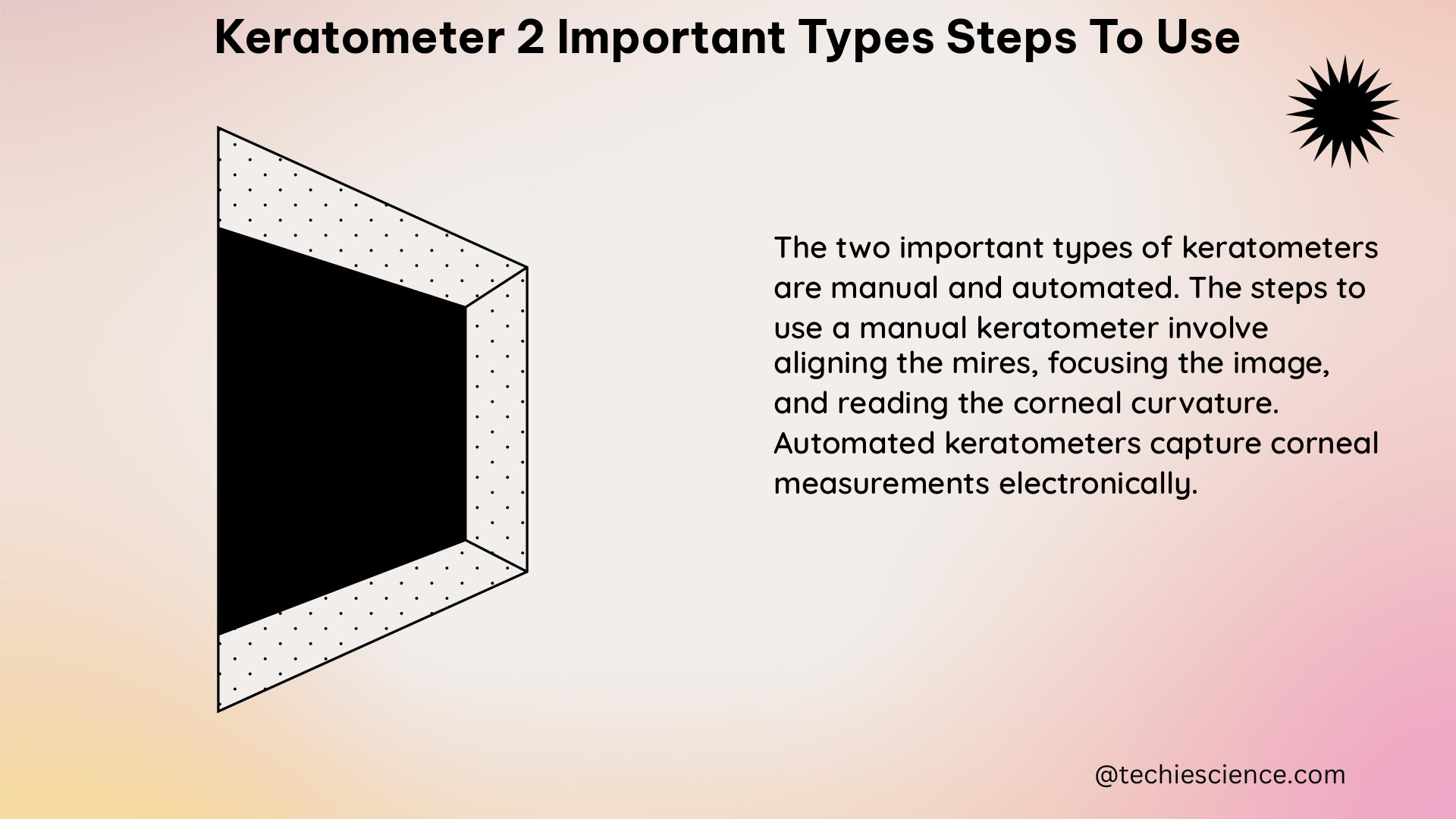Summary
Keratometers are essential instruments used in ophthalmology to measure the curvature of the cornea, which is a crucial factor in determining the refractive power of the eye. The two important types of keratometers are manual keratometers and automated keratometers. Manual keratometers use movable mires or prisms to assess corneal curvature, while automated keratometers employ photosensors to measure the same. Both types provide valuable data, such as the flat and steep meridians of the cornea, the keratometric difference, and additional measurements like the axis of astigmatism and corneal thickness. Understanding the proper steps to use these instruments is crucial for accurate and reliable keratometry measurements.
Manual Keratometers: Principles and Procedures

Principles of Manual Keratometers
Manual keratometers, also known as manual ophthalmometers, operate on the principle of reflection. They use a series of movable mires or prisms to assess the curvature of the cornea. The cornea acts as a convex mirror, reflecting the mires or prisms onto the retina. By analyzing the size and position of these reflected images, the instrument can determine the radius of curvature of the cornea.
The key components of a manual keratometer include:
- Mires or Prisms: These are the movable elements that project a pattern of light onto the cornea. The reflected pattern is then observed and measured.
- Focusing Mechanism: This allows the user to adjust the focus of the instrument to ensure a clear and sharp image of the reflected mires or prisms.
- Measurement Scales: The instrument is equipped with scales that provide readings in diopters (D) for the flat (K1) and steep (K2) meridians of the cornea.
Procedure for Using a Manual Keratometer
- Patient Positioning: The patient should be seated comfortably, with their chin resting on the chin rest and their forehead against the forehead rest of the keratometer.
- Instrument Alignment: The examiner should align the keratometer with the patient’s eye, ensuring that the mires or prisms are centered on the cornea.
- Focusing: The examiner should adjust the focusing mechanism of the keratometer until the reflected mires or prisms are sharp and clear.
- Measurement: The examiner should read the measurements for the flat (K1) and steep (K2) meridians of the cornea from the instrument’s scales. The difference between these two readings is known as the keratometric difference or K-difference.
- Astigmatism Measurement: The keratometer can also provide information about the axis of astigmatism, which is the orientation of the steep and flat meridians of the cornea.
It is important to note that manual keratometers require a certain level of skill and experience to use effectively, as the examiner must be able to properly align the instrument and interpret the reflected mire or prism patterns.
Automated Keratometers: Principles and Procedures
Principles of Automated Keratometers
Automated keratometers, on the other hand, use advanced technology to measure corneal curvature. These devices employ photosensors to capture images of the cornea and specialized software to analyze the data. The software compares the patient’s corneal measurements with a standard value database to provide accurate and objective readings.
The key components of an automated keratometer include:
- Photosensors: These are specialized sensors that capture high-resolution images of the cornea.
- Software: The software analyzes the captured images and provides measurements of the corneal curvature, as well as other parameters such as the axis of astigmatism and corneal thickness.
- User Interface: Automated keratometers typically have a user-friendly interface that allows the examiner to input patient information, initiate the measurement process, and view the results.
Procedure for Using an Automated Keratometer
- Patient Positioning: The patient should be seated comfortably, with their chin resting on the chin rest and their forehead against the forehead rest of the keratometer.
- Instrument Alignment: The examiner should align the keratometer with the patient’s eye, ensuring that the photosensors are properly positioned to capture the corneal image.
- Measurement: The examiner should initiate the measurement process, which typically involves the keratometer automatically capturing one or more images of the cornea.
- Data Analysis: The software within the automated keratometer will analyze the captured images and provide the measurements for the flat (K1) and steep (K2) meridians of the cornea, as well as other parameters such as the axis of astigmatism and corneal thickness.
- Result Interpretation: The examiner should review the results displayed on the user interface and interpret the data, taking into account any potential sources of error or variability.
Automated keratometers are generally more user-friendly and provide more accurate and consistent measurements compared to manual keratometers. However, it is still important for the examiner to understand the principles of keratometry and the potential sources of error to ensure accurate and reliable measurements.
Comparison of Manual and Automated Keratometers
| Feature | Manual Keratometers | Automated Keratometers |
|---|---|---|
| Measurement Principle | Reflection of mires or prisms | Photosensor-based image capture and analysis |
| Measurement Accuracy | Dependent on examiner skill and experience | Generally more accurate and consistent |
| Measurement Parameters | Flat (K1) and steep (K2) meridians, K-difference | Flat (K1) and steep (K2) meridians, K-difference, axis of astigmatism, corneal thickness |
| User Interaction | Requires manual alignment, focusing, and reading of scales | Automated measurement process with user-friendly interface |
| Portability | Typically more portable and compact | May be larger and less portable |
| Cost | Generally less expensive | Typically more expensive |
Sources of Error and Considerations in Keratometry
Keratometry measurements can be subject to various sources of error, which can affect the accuracy and reliability of the results. Some of the key considerations include:
- Instrument Alignment: Proper alignment of the keratometer with the patient’s eye is crucial. Misalignment can lead to inaccurate measurements.
- Eye Movement: Patient eye movement during the measurement process can introduce errors. Proper patient positioning and instructions are essential.
- Tear Film Variations: Changes in the tear film can affect the reflective properties of the cornea, leading to variations in measurements.
- Corneal Irregularities: Conditions such as keratoconus or corneal scarring can cause irregular corneal curvature, which may not be accurately captured by the keratometer.
- Instrument Calibration: Regular calibration of the keratometer is necessary to ensure accurate and consistent measurements.
To minimize these sources of error, it is important to follow proper measurement protocols, ensure proper patient positioning, and regularly maintain and calibrate the keratometer.
Conclusion
Keratometers, both manual and automated, are essential instruments in ophthalmology for measuring the curvature of the cornea. Understanding the principles and procedures for using these devices is crucial for obtaining accurate and reliable keratometry measurements. By familiarizing themselves with the two important types of keratometers and the steps involved in their use, healthcare professionals can provide better diagnostic and treatment services to their patients.
References
- Eye Patient. (n.d.). Keratometry Test. Retrieved from https://eyepatient.net/Home/articledetail/keratometry-test-413
- SlideShare. (2014, February 20). keratometry | PPT – SlideShare. Retrieved from https://www.slideshare.net/slideshow/keratometry-31466440/31466440
- NCBI Bookshelf. (n.d.). Keratometer. Retrieved from https://www.ncbi.nlm.nih.gov/books/NBK580516/
- ScienceDirect Topics. (n.d.). Keratometer – an overview. Retrieved from https://www.sciencedirect.com/topics/nursing-and-health-professions/keratometer
- ScienceDirect Topics. (n.d.). Keratometer – an overview. Retrieved from https://www.sciencedirect.com/topics/medicine-and-dentistry/keratometer

Hi, I am Sanchari Chakraborty. I have done Master’s in Electronics.
I always like to explore new inventions in the field of Electronics.
I am an eager learner, currently invested in the field of Applied Optics and Photonics. I am also an active member of SPIE (International society for optics and photonics) and OSI(Optical Society of India). My articles are aimed at bringing quality science research topics to light in a simple yet informative way. Science has been evolving since time immemorial. So, I try my bit to tap into the evolution and present it to the readers.
Let’s connect through